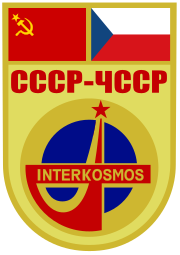 The Soyuz 28 return capsule, on display at the Prague Aviation Museum, Kbely | |
| Operator | Soviet space program |
|---|---|
| COSPAR ID | 1978-023A |
| SATCAT no. | 10694 |
| Mission duration | 7 days, 22 hours and 16 minutes |
| Orbits completed | 125 |
| Spacecraft properties | |
| Spacecraft type | Soyuz 7K-T |
| Manufacturer | NPO Energia |
| Launch mass | 6,800 kg (15,000 lb) |
| Crew | |
| Crew size | 2 |
| Members | Aleksei Gubarev Vladimír Remek |
| Callsign | Зенит (Zenit – "Zenith") |
| Start of mission | |
| Launch date | 2 March 1978, 15:28:10 UTC |
| Rocket | Soyuz-U |
| Launch site | Baikonur 1/5[1] |
| End of mission | |
| Landing date | 10 March 1978, 13:44:10 UTC |
| Landing site | 51°03′N 66°42′E / 51.05°N 66.7°E |
| Orbital parameters | |
| Reference system | Geocentric |
| Regime | Low Earth |
| Perigee altitude | 198.9 km (123.6 mi) |
| Apogee altitude | 275.6 km (171.2 mi) |
| Inclination | 51.65 degrees |
| Period | 88.95 minutes |
| Docking with Salyut 6[2] | |
| Docking port | Aft |
| Docking date | 3 March 1978, 17:09:30 UTC |
| Undocking date | 10 March 1978, 10:23:30 UTC |
| Time docked | 6 days, 17 hours and 14 minutes |

 Gubarev (left) and Remek (right) | |
Soyuz 28 (Russian: Союз 28, Union 28) was a March 1978 Soviet crewed mission to the orbiting Salyut 6 space station.[2] It was the fourth mission to the station, the third successful docking, and the second visit to the resident crew launched in Soyuz 26.
Cosmonaut Vladimír Remek from Czechoslovakia became the first person launched into space who was not a citizen of the United States or the Soviet Union. The other crew member was Aleksei Gubarev. The flight was the first mission in the Intercosmos program that gave Eastern Bloc and other communist states access to space through crewed and uncrewed launches.